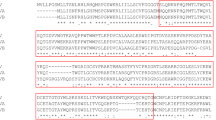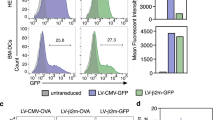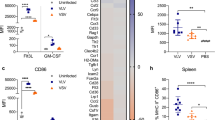Abstract
The envelope glycoprotein from vesicular stomatitis virus (VSV-G) has been used extensively to pseudotype lentiviral vectors, but has several drawbacks including cytotoxicity, potential for priming of immune responses against transgene products through efficient transduction of antigen-presenting cells (APCs) and sensitivity to inactivation by human complement. As an alternative to VSV-G, we extensively characterized lentiviral vectors pseudotyped with the gp64 envelope glycoprotein from baculovirus both in vitro and in vivo. We demonstrated for the first time that gp64-pseudotyped vectors could be delivered efficiently in vivo in mice via portal vein injection. Following delivery, the efficiency of mouse cell transduction and the transgene expression is comparable to VSV-G-pseudotyped vectors. In addition, we found that gp64-pseudotyped lentiviral vectors could efficiently transduce a variety of cell lines in vitro, although gp64 showed a more restricted tropism than VSV-G, with especially poor ability to transduce hematopoietic cell types including dendritic cells (DCs). Although we found that gp64-pseudotyped vectors are also sensitive to inactivation by human complement, gp64 nevertheless has advantages over VSV-G, because of its lack of cytotoxicity and narrower tropism. Consequently, gp64 is an attractive alternative to VSV-G because it can efficiently transduce cells in vivo and may reduce immune responses against the transgene product or viral vector by avoiding transduction of APCs such as DCs.
This is a preview of subscription content, access via your institution
Access options
Subscribe to this journal
Receive 12 print issues and online access
$259.00 per year
only $21.58 per issue
Buy this article
- Purchase on Springer Link
- Instant access to full article PDF
Prices may be subject to local taxes which are calculated during checkout





Similar content being viewed by others
References
Emi N, Friedmann T, Yee JK . Pseudotype formation of murine leukemia virus with the G protein of vesicular stomatitis virus. J Virol 1991; 65: 1202–1207.
Burns JC et al. Vesicular stomatitis virus G protein pseudotyped retroviral vectors: concentration to very high titer and efficient gene transfer into mammalian and nonmammalian cells. Proc Natl Acad Sci USA 1993; 90: 8033–8037.
Yee JK, Friedmann T, Burns JC . Generation of high-titer pseudotyped retroviral vectors with very broad host range. Methods Cell Biol 1994; 43: 99–112.
Ory DS, Neugeboren BA, Mulligan R . A stable human-derived packaging cell line for production of high titer retrovirus/vesicular stomatitis virus G pseudotypes. Proc Natl Acad Sci USA 1996; 93: 11400–11406.
Farson D et al. A new-generation stable inducible packaging cell line for lentiviral vectors. Hum Gene Ther 2001; 12: 981–997.
Kafri T, van Praag H, Ouyang L, Gage FH . A packaging cell line for lentivirus vectors. J Virol 1999; 73: 576–584.
Dyall J, Latouche JB, Schnell S, Sadelain M . Lentivirus-transduced human monocyte-derived dendritic cells efficiently stimulate antigen-specific cytotoxic T lymphocytes. Blood 2001; 97: 114–121.
Chinnasamy N et al. Efficient gene transfer to human peripheral blood monocyte-derived dendritic cells using human immunodeficiency virus type 1-based lentiviral vectors. Hum Gene Ther 2000; 11: 1901–1909.
Metharom P, Ellem KA, Schmidt C, Wei MQ . Lentiviral vector-mediated tyrosinase-related protein 2 gene transfer to dendritic cells for the therapy of melanoma. Hum Gene Ther 2001; 12: 2203–2213.
VandenDriessche T et al. Lentiviral vectors containing the human immunodeficiency virus type-1 central polypurine tract can efficiently transduce nondividing hepatocytes and antigen-presenting cells in vivo. Blood 2002; 100: 813–822.
Welsh RMJ, Cooper NR, Jensen FC, Oldstone MB . Human serum lyses RNA tumour viruses. Nature 1975; 257: 612–614.
Takeuchi Y, Porter C, Strahan K . Sensitization of cells and retroviruses to human serum by alpha(1–3)galactosyltransferase. Nature 1996; 379: 85–88.
Takeuchi Y, Liong SH, Bieniasz PD . Sensitization of rhabdo-, lenti-, and spumaviruses to human serum by galactosyl(alpha1–3)galactosylation. J Virol 1997; 71: 6174–6178.
DePolo NJ et al. VSV-G pseudotyped lentiviral vector particles produced in human cells are inactivated by human serum. Mol Ther 2000; 2: 218–222.
Sandrin V et al. Lentiviral vectors pseudotyped with a modified RD114 envelope glycoprotein show increased stability in sera and augmented transduction of primary lymphocytes and CD34+ cells derived from human and nonhuman primates. Blood 2002; 100: 823–832.
Kost TA, Condreay JP . Recombinant baculoviruses as mammalian cell gene-delivery vectors. Trends Biotechnol 2002; 20: 173–180.
Hofmann C et al. Efficient gene transfer into human hepatocytes by baculovirus vectors. Proc Natl Acad Sci USA 1995; 92: 10099–10103.
Sandig V et al. Gene transfer into hepatocytes and human liver tissue by baculovirus vectors. Hum Gene Ther 1996; 7: 1937–1945.
Shoji I et al. Efficient gene transfer into various mammalian cells, including non-hepatic cells, by baculovirus vectors. J Gen Virol 1997; 78: 2657–2664.
Condreay JP, Witherspoon SM, Clay WC, Kost TA . Transient and stable gene expression in mammalian cells transduced with a recombinant baculovirus vector. Proc Natl Acad Sci USA 1999; 96: 127–132.
Boyce FM, Bucher NL . Baculovirus-mediated gene transfer into mammalian cells. Proc Natl Acad Sci USA 1996; 93: 2499–2504.
Kumar M, Bradow BP, Zimmerberg J . Large-scale production of pseudotyped lentiviral vectors using baculovirus gp64. Hum Gene Ther 2003; 14: 67–77.
Dull T et al. A third generation lentiviral vector with a conditional packaging system. J Virol 1998; 72: 8463–8471.
Gallardo HF, Tan C, Ory D, Sadelain M . Recombinant retroviruses pseudotyped with the vesicular stomatitis virus G glycoprotein mediate both stable gene transfer and pseudotransduction in human peripheral blood lymphocytes. Blood 1997; 90: 952–957.
Liu ML, Winther BL, Kay MA . Pseudotransduction of hepatocytes by using concentrated pseudotyped vesicular stomatitis virus G glycoprotein (VSV-G)-Moloney murine leukemia virus-derived retrovirus vectors: comparison of VSV-G and amphotropic vectors for hepatic gene transfer. J Virol 1996; 70: 2497–2502.
Gruber A et al. Dendritic cells transduced by multiply deleted HIV-1 vectors exhibit normal phenotypes and functions and elicit an HIV-specific cytotoxic T-lymphocyte response in vitro. Blood 2000; 96: 1327–1333.
High KA . Gene transfer as an approach to treating hemophilia. Circ Res 2001; 88: 137–144.
Hofmann C, Strauss M . Baculovirus-mediated gene transfer in the presence of human serum or blood facilitated by inhibition of the complement system. Gene Therapy 1998; 5: 531–536.
Sarkis C et al. Efficient transduction of neural cells in vitro and in vivo by a baculovirus-derived vector. Proc Natl Acad Sci USA 2000; 97: 14638–14643.
Huser A, Rudolph M, Hofmann C . Incorporation of decay-accelerating factor into the baculovirus envelope generates complement-resistant gene transfer vectors. Nat Biotechnol 2001; 19: 451–455.
Chernomordik L, Leikina E, Cho MS, Zimmerberg J . Control of baculovirus gp64-induced syncytium formation by membrane lipid composition. J Virol 1995; 69: 3049–3058.
Tani H et al. Characterization of cell-surface determinants important for baculovirus infection. Virology 2001; 279: 343–353.
Wickham TJ et al. Equilibrium and kinetic analysis of Autographa californica nuclear polyhedrosis virus attachment to different insect cell lines. J Gen Virol 1992; 73 (Part 12): 3185–3194.
Wang P, Hammer DA, Granados RR . Binding and fusion of Autographa californica nucleopolyhedrovirus to cultured insect cells. J Gen Virol 1997; 78 (Part 12): 3081–3089.
Charan S, Hengartner H, Zinkernagel RM . Antibodies against the two serotypes of vesicular stomatitis virus measured by enzyme-linked immunosorbent assay: immunodominance of serotype-specific determinants and induction of asymmetrically cross-reactive antibodies. J Virol 1987; 61: 2509–2514.
Kavanaugh MP et al. Cell-surface receptors for gibbon ape leukemia virus and amphotropic murine retrovirus are inducible sodium-dependent phosphate symporters. Proc Natl Acad Sci USA 1994; 91: 7071–7075.
Menoret S et al. lacZ transgenic rats tolerant for beta-galactosidase: recipients for gene transfer studies using lacZ as a reporter gene. Hum Gene Ther 2002; 13: 1383–1390.
Xu L et al. Transduction of hepatocytes after neonatal delivery of a Moloney murine leukemia virus based retroviral vector results in long-term expression of beta-glucuronidase in mucopolysaccharidosis VII dogs. Mol Ther 2002; 5: 141–153.
Follenzi A et al. Efficient gene delivery and targeted expression to hepatocytes in vivo by improved lentiviral vectors. Hum Gene Ther 2002; 13: 243–260.
Finer MH et al. kat: a high-efficiency retroviral transduction system for primary human T lymphocytes. Blood 1994; 83: 43–50.
Tsui LV et al. Production of human clotting Factor IX without toxicity in mice after vascular delivery of a lentiviral vector. Nat Biotechnol 2002; 20: 53–57.
Simmons AD, Horton S, Abney AL, Johnson JE . Neurogenin2 expression in ventral and dorsal spinal neural tube progenitor cells is regulated by distinct enhancers. Dev Biol 2001; 229: 327–333.
Acknowledgements
We thank Minh Nguyen for experimental assistance and comments on the manuscript. We also thank Jeanette Dilley, Trini Arroyo, Debbie Farson and Hend Omran for cell lines, as well as Alanna Weissman-Ward, Jim Liu and Pratima Kundu for vector production and purification. In addition, we are grateful to Melissa Gonzalez, who performed the liver histology, Sandy Sanchez for DNA sequencing and oligo synthesis, Satya Yendluri for providing the Factor IX ELISA protocol and especially to members of the Cell Genesys animal facility including Melinda vanRoey, Tammy Langer, Sheila Tanciongo, Amanda Koehne and Jacki Gire. Final thanks go to all the members of the lentiviral vector group for helpful discussions and Andy Simmons and Tom Harding for critical reading of the manuscript.
Author information
Authors and Affiliations
Rights and permissions
About this article
Cite this article
Schauber, C., Tuerk, M., Pacheco, C. et al. Lentiviral vectors pseudotyped with baculovirus gp64 efficiently transduce mouse cells in vivo and show tropism restriction against hematopoietic cell types in vitro. Gene Ther 11, 266–275 (2004). https://doi.org/10.1038/sj.gt.3302170
Received:
Accepted:
Published:
Issue Date:
DOI: https://doi.org/10.1038/sj.gt.3302170
Keywords
This article is cited by
-
Baculovirus mediated transduction: analysis of vesicular stomatitis virus glycoprotein pseudotyping
VirusDisease (2014)
-
Baculovirus: an Insect-derived Vector for Diverse Gene Transfer Applications
Molecular Therapy (2013)
-
Abrogation of contaminating RNA activity in HIV-1 Gag VLPs
Virology Journal (2011)
-
A MicroRNA-regulated and GP64-pseudotyped Lentiviral Vector Mediates Stable Expression of FVIII in a Murine Model of Hemophilia A
Molecular Therapy (2011)
-
Reduction of liver macrophage transduction by pseudotyping lentiviral vectors with a fusion envelope from Autographa californicaGP64 and Sendai virus F2 domain
BMC Biotechnology (2009)



